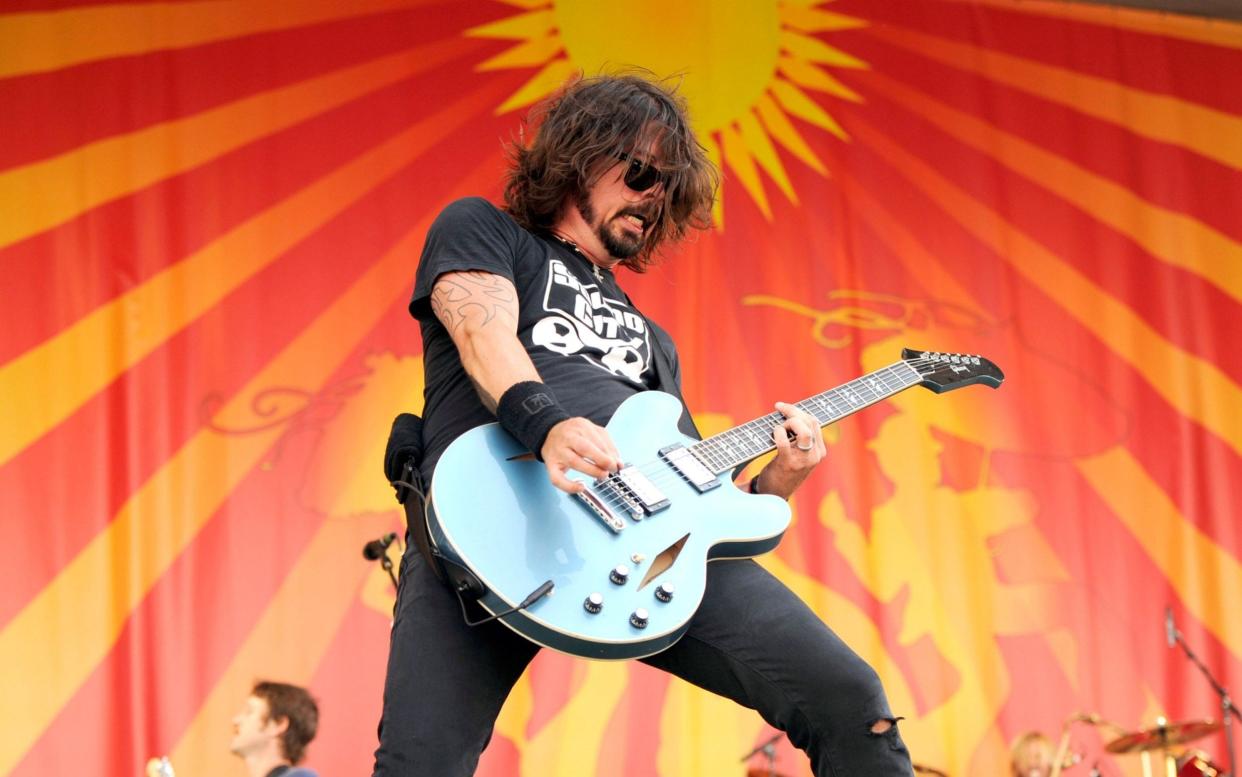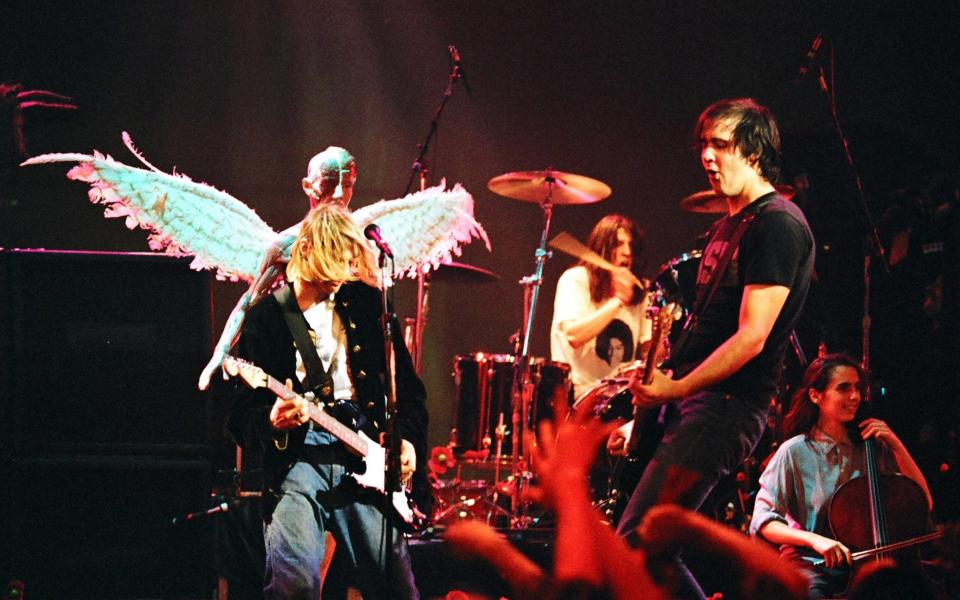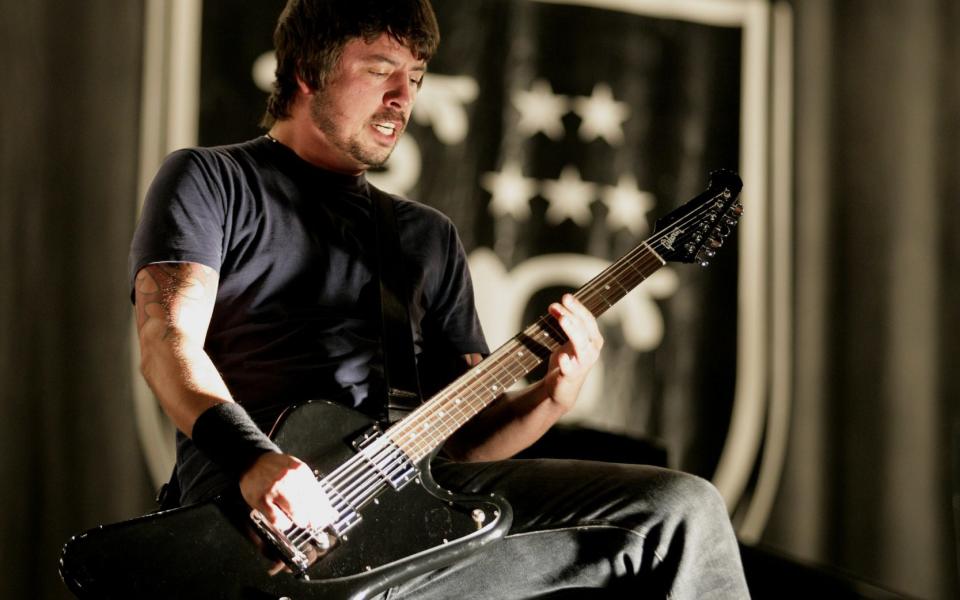‘One lost soul's attempt at making sense of a world crumbling beneath his feet’: how Dave Grohl faced the music

- Oops!Something went wrong.Please try again later.
It seems impossible to imagine now, but once upon a time, Dave Grohl was “afraid of music.”
“If I heard a song that even touched on an emotion in me, I would turn it off,” he told Anderson Cooper on CBS’ 60 Minutes in 2014. “I was so terrified because to me, that’s what music always was. It was a direct connection to my heart.”
Grohl begun to feel disconnected from music in 1994, a year synonymous with the suicide of his friend and bandmate Kurt Cobain and the subsequent disbandment of Nirvana. Grief manifested for Grohl not in the form of tears (“I remember trying to make myself cry and I just couldn’t,” he once admitted) but rather as numbness. “I just shut down.” With that, he questioned whether he had any desire to continue making music at all.
But then, music would was the best form of therapy he could find. Foo Fighters was recorded over five days in October 1994, and every riff (bar a guest turn on X-Static from Greg Dull), every crash of the cymbal and every lyric was written and performed by Grohl himself. The only person who knew he was recording at this time was his producer, Barrett Jones.
“I met Dave when he was 14, [when I] recorded his first band, and we became very good friends,” says Jones. “We basically hung out all the time.” Jones had been the sound man for Grohl’s one time hardcore band Scream in the late Eighties, and they lived together at the peak of Nirvana’s success until Grohl bought his own house in 1993. “I’m sure that was one of the reasons he wanted me to do [the record] because we were so comfortable together and had a system down.”

Familiarity and comfort Grohl needed on multiple levels. All but three of the tracks he recorded were songs he had in his back pocket, written in moments of downtime on tour with Nirvana. Most of them Grohl had been too shy to show anyone. He was shyer still about his singing. “[He] always wanted to double and triple track his vocals all the time,” says Jones. “I was always very encouraging to him, I think.” There was no fanfare and there was no mourning. “I rarely saw him in any sort of down mood,” says Jones – there was just music. “Distraction was the essence of what we did.”
Jones says that music is Grohl’s “purest form of being” and on Foo Fighters, it truly shows. Only intending, initially, for close friends to hear them, and using a band-like pseudonym on the cover, Grohl revels in making music however the hell he wants. A couple of songs (Weenie Beenie, Wattershed) are the best Nirvana B-sides you’ve never heard, while Big Me is an unabashed love letter to REM and Tom Petty. Many other songs – I’ll Stick Around, the title track, Alone + Easy Target – are simply a masterclass in big, powerful post-grunge esque rock songs.
Those demos floated around the underground for a while, later receiving their radio debut courtesy of Pearl Jam’s Eddie Vedder on his DIY radio show Self-Pollution Radio. It wasn’t long before everyone was looking at Dave Grohl and, more accustomed to performing behind a drumkit at the back of the stage, this felt inevitably foreign. Speaking to journalist Paul Brannigan for his 2011 biography This Is A Call: The Life and Times of Dave Grohl, Grohl admitted that he never imagined becoming a frontman, and felt uncomfortable with the prospect.

“The responsibility of being someone larger than life seemed too much for me,” he said. When the Foos began to tour as a proper band – with Nate Mendel on bass, Pat Smear on guitar and William Goldsmith on drums – some critics perhaps sensed Grohl’s reservations about performing centre-stage rather than at the back. Reviewing their debut show in February 1995, frontman of hardcore punk band Poison Idea, Jerry A, wrote that “compared to Kurt, Grohl has neither the charisma or the entertaining stage presence.”
Comparisons to Nirvana would beleaguer the band for years, even in reviews of their second album The Colour and the Shape, released three years after Cobain’s death. “The main challenge for us [at this time] was to establish our own identity and not use Dave’s past as a crutch,” recognised Nate Mendel. Despite his greenness as a frontman, however, reviewers still saw Grohl’s potential, with Kerrang!’s Kevan Roberts declaring him “the best kept secret in rock.”
Yet It wasn’t just Foo Fighters’ debut that came out of personal tumult. While recording follow up album The Colour and the Shape, divorce papers were delivered to the studio. Grohl’s two year marriage to photographer Jennifer Youngblood had fallen apart. “We just shouldn’t have [got married],” Grohl recalled in another interview with Paul Brannigan. “Even in the time we were engaged I think we both realised that we probably shouldn’t get married. And then Kurt died and our whole world turned upside down and so in a way, I think I clung to that engagement and the marriage as like my last piece of stability.”
The arrival of the divorce papers couldn’t have come at a worse time. The atmosphere in the studio was turning sour. None of the band expected recording with renowned producer Gil Norton to be as rigorous as it was, let alone to the point of demoralisation. It seemed that no take was good enough, especially from Mendel and Goldsmith, who the latter revealed in a documentary that Norton dubbed them “the rhythm-less section”.
Goldsmith struggled the most in this environment. Other members of the band, and Norton himself, recognised, in retrospect, that he perhaps felt “intimidated”, in Grohl’s words, by Norton and this led to a feeling of insecurity, especially given Grohl’s drumming prestige. Grohl later re-tracked the drums for lead single Monkey Wrench and re-trackings of Pat Smear and Mendel’s parts followed suit. Goldsmith’s presence became redundant. He left the band shortly after, and Grohl has regretted how it happened ever since.
Friction within a band is rarely translated to tape, but Grohl’s personal struggles, however, did colour the record. Though the bulk of Foo Fighters is distinctly impersonal (“There was too much to say [about Cobain’s death],” Grohl has said), with nonsense lyrics padding out some of its verses, The Colour and the Shape sees him explore his frustrations to music.
Monkey Wrench directly addresses his divorce, and in Brannigan’s words, much of the rest of the album comes across as ‘one lost soul’s attempt to make sense of a world crumbling beneath his feet’. Yet just as Foo Fighters is not Grohl’s grief record, The Colour and the Shape is not his divorce record – it is probably recognised more as “the album with Everlong on it”.
Right from the days where critics pushed them into the shadows of Nirvana, the Foos might have let circumstance inspire them, but they have refused to let it define them. Having outsold and outperformed his previous band, they became their own band through the means of defiance – and of course, with a slew of brilliant songs.
Medicine at Midnight is out Feb 5

